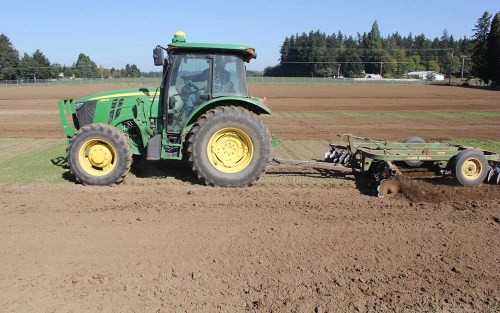Economists: Agriculture a key driver in Oregon’s economy
Published 3:00 pm Thursday, October 7, 2021

- Agriculture continues to play a significant role in Oregon’s economy, according to a new analysis.
CORVALLIS — Throughout Oregon’s economy, more than 15% of sales and 20% of jobs are tied in some way to agriculture, food and fiber, according to a new analysis by Oregon State University in partnership with the state Department of Agriculture.
The 27-page report provides an overview of the industry and recent trends. Researchers update the analysis every 5-6 years, with the last update in 2015.
Trending
Jeff Reimer, a professor of applied economics at OSU and co-author of the report, said the analysis also delves into the links between agriculture, food and fiber and other sectors of the economy that may not be apparent looking at raw statistics.
For example, the report shows that agriculture, food and fiber production is directly responsible for more than $42 billion in sales and 371,300 full- and part-time jobs. That represents approximately 10% of total sales and 14% of jobs.
But after taking into account support industries such as agricultural inputs, transportation and retail, the total shares grow to more than $71 billion in sales and 531,422 jobs.
Bruce Sorte, an economist with OSU Extension Service, said he calculates the interdependence of economic sectors using an internet-based application called IMPLAN — an input-output modeling tool that can be used for everything from french fries made in Hermiston to beef and potatoes grown in Klamath Falls.
While data from the latest USDA Census of Agriculture in 2017 shows Oregon eclipsed $5 billion in farm gate value, Sorte said there is more to the story.
“Talking about agriculture without talking about getting to the dinner plate misses a big part of it,” he said, “especially during this pandemic.”
Trending
Rising exports
Oregon’s agricultural exports have grown by 13.7% since 2015, with sales jumping from $15.2 billion to $17.3 billion.
Production of agricultural exports dipped slightly, from $3.3 billion to $3.1 billion. Though the analysis did not give a precise reason, it did mention the U.S.-China trade war that likely impacted exports of wheat, hazelnuts, cherries and beef.
However, the decline was more than made up by increases in agricultural support services, food and fiber processing, with Oregon’s food and beverage sector playing an outsize role.
Sorte said Oregon is in a strong position to continue increasing agricultural exports as farmers become more efficient.
“The fact that acreage changes have been low, and yet the output on that acreage has dramatically increased … we’re in a very good position, depending on the strength of the dollar, to really do a good job in increasing our exports,” Sorte said.
Organic growth
One area where Sorte said he was pleasantly surprised was the growth of organic farming and ranching.
Despite the number of certified organic farms decreasing from 657 in 2008 to 455 in 2019, the number of certified organic acres nearly doubled from 105,605 to 196,045.
The value of organic products sold also increased from $156 million to $454 million, making up 9% of the total value of market sales in Oregon.
“Organic farming has grown from a niche market to a segment of the market that includes very small farms to large corporate farms,” the report states. “Retail food chains and restaurants continue to expand their organic offerings and the majority of organic products are now sold through retail food outlets.”
Mid-size farms decline
Overall, Oregon added more than 2,000 new farms since 2012. However, consistent with national trends, the number of mid-size farms has continued to decline.
For example, there were 3,417 new farms established with 1-9 acres, and 21 new farms with 2,000-plus acres. But the number of farms between 50 and 999 acres dropped by 1,217.
The rise in small farms likely reflects growth in organic farming, value-added on-farm operations, direct sales and agritourism, according to the report.
Meanwhile, large farms reflect the industry’s move toward consolidation to attain economies of scale. Those two factors have combined to squeeze mid-size operations.
Overall, the number of acres in agricultural production has declining a little more than 9% since 1997, from 17.7 million to 16 million acres.
Hemp and marijuanaWhile the economic impact of hemp and marijuana remains speculative due the industry’s nascent status, the report does include some projections compiled by Gordon Jones, an assistant professor at OSU’s Southern Oregon Research and Extension Center.
As of Sept. 6, Oregon had 7,175 registered acres of hemp, according to the Oregon Department of Agriculture. That is down from a high of 60,000 acres in 2019.
Jones’ estimates show growers can earn a potential gross revenue of $15,000 to $25,000 per acre, primarily through oils such as cannabidiol, or CBD, extracted from hemp flowers. Regulatory uncertainty, however, has kept many risk-averse companies from engaging in hemp markets, clouding the outlook.
More data exist on recreational marijuana, which was legalized in Oregon in 2015 and has since grown into a $1.4 billion industry that employs nearly 10,000 people.
COVID-19 impacts
While the full impacts of the pandemic are still being unraveled, Oregon’s foodservice industry was dealt a major blow.
Between 2019 and the third fiscal quarter of 2020, the sector saw a nearly 15% decline in sales and 23% decline in employment amid pandemic closures. Farms and food processors also were forced to scramble to find new buyers for their products.
Farm gate sales declined to their lowest point in over a decade, though the USDA still expects overall U.S. farm income to increase 43% from 2019 due in large part to government assistance programs.
Since Oregon has a lower percentage of commodity crops like soybeans and corn, and is more diverse in terms of specialty crops, OSU researchers say they anticipate the state’s reported farm income will be somewhat lower than national averages.
Sorte said the pandemic also has significantly accelerated the mechanization of farms and food processing, posing a challenge in rural communities as the labor market is disrupted.
“Although the employers are struggling to find workers right now, I expect that to be far less difficult after COVID, particularly in food processing,” he said. “Workers who are reluctant to return to work now may find those jobs are not available post-COVID.”
Some additional figures outlined in the Oregon agriculture, food and fiber economic analysis, published in August by Oregon State University:
• 16 million acres is farmed across Oregon — an area roughly the size of West Virginia.
• 225 agricultural commodities are grown statewide.
• 2,000-plus new farms have been established since 2012.
• 95% of farms in Oregon are family-owned.
• 5.7% of Oregon jobs are on farms.









